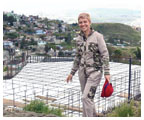|
Web Exclusives: Alumni Spotlight Sept 27 , 2006:
Building schools in Tijuana
Christine Brady ’79 did not know any Mexicans while growing up in Bucks County, Pa. And yet, since she crossed into Mexico to work 20 years ago, Brady has dedicated her life to the residents of Tijuana’s Colonia Esperanza. For her relentless effort building schools in this colonia of 180,000 people — which she describes as a squatters’ community without utilities — she received the United Nations Eleanor Roosevelt Human Rights Award in October 2005. Brady, who lives near the border, in Chula Vista, Calif., first discovered Colonia Esperanza when she was on maternity leave from her engineering job with the Naval Ocean Systems Center in San Diego. She saw a news report about orphanages in Tijuana, and decided to begin her crusade to improve the lives of children across the border. Several times a week Brady volunteered at an orphanage, where she met a little girl named Alma Cecilia. Alma had been vaccinated with a needle contaminated by hepatitis B, and when she fell ill, Brady planned to adopt her; that is, until the girl’s mother reclaimed her and took her back to the home where she was born. Brady accompanied them home, and cried when she saw the colonia. Instead of pursuing an adoption, Brady decided to do something that would help more than just one family: She quit her job, and, using her savings, put together a team of Mexican medical professionals — two doctors, a dentist, and a psychologist — plus a priest and a volunteer journalist, Carol Hasson ’76, to treat and educate the residents of colonias. Because the peso had just been devalued, she paid the medical professionals only $65 a week. Brady and her team quickly realized that the best solution to the problems in the colonias was education. When PAW profiled Brady in 1991, she had built a one-room schoolhouse for kindergarten students. Since then, she has built an elementary school and a high school. In Mexico, says Brady, “high school isn’t required, and the teenagers ... were just hanging out” or working to help support their families. Though most of the buildings are bare-bones structures — the high school, for example, has window openings and doorways but lacks windows and doors — the 300 students enrolled in the three schools enjoy a couple of educational enrichment programs: an Internet laboratory with 25 computers (donated by members of Princeton’s Class of 1938) and ballet lessons, which are mandatory for boys and girls alike. The Class of 1979 adopted the schools as its community service project in 1996. Before majoring in physics at Princeton, Brady studied ballet in New York City for six years. She has brought her love of dance to Colonia Esperanza, teaching classes and bringing in ballet teachers from Russia. Dance, she says, “opens up the world” to the children. When Brady is not pouring concrete, fundraising (through the foundation
she started, www.americasfoundation.net), or teaching ballet and
high school English, she is lobbying for the rights of the children
of Tijuana. There are approximately 3 million people in Tijuana,
and nearly half are under the age of 16. “This is a city of
children,” Brady says, “and they don’t have a
voice. I’m trying to make people aware that the children exist,
that they have needs, and that we need to be responsive to those
needs.” By Nicole Oncina ’05 Nicole Oncina ’05 is a freelance writer and photographer in San Francisco.
|
||

